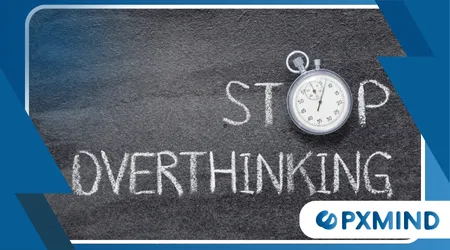Come gestire i pensieri eccessivi senza autogiudizio

Gestisci il pensiero eccessivo. Pensare troppo è un'abitudine mentale complessa e spesso debilitante, che può dare la sensazione di essere intrappolati in un labirinto da noi stessi creato.
Annunci
Rivedi le conversazioni, analizzi le decisioni e prevedi gli scenari peggiori, il tutto mentre un coro di autocritica risuona in sottofondo.
La vera sfida, tuttavia, non è solo fermare i pensieri, ma imparare come gestire il pensiero eccessivo in un modo che non aggiunga un ulteriore strato di auto-recriminazione a un fardello già pesante.
Per molti, il primo istinto è quello di combattere i pensieri, di cercare di reprimerli, il che spesso porta a un circolo vizioso di vergogna.
"Perché non riesco semplicemente a smettere?" diventa una domanda che alimenta il fuoco, peggiorando il problema dei pensieri eccessivi.
E se la soluzione non fosse il controllo, ma l'accettazione? Riconoscere il pensiero senza giudicarlo è il primo passo verso la pace.
Il problema dell'autocritica
Quando pensi troppo, la tua mente spesso presenta questi pensieri come minacce e la tua risposta interna è il panico.
Questo panico è spesso accompagnato da una severa critica interiore. Questa voce potrebbe dirti che sei debole, disorganizzato o incapace di prendere una decisione semplice.
Più ascolti questa voce, più rafforzerai la convinzione che i tuoi pensieri sono un riflesso del tuo carattere.
Questo autogiudizio non è solo inutile, ma rappresenta un ostacolo importante al cambiamento. Trasforma un processo mentale neutrale in un fallimento morale.
Ad esempio, potresti passare ore ad analizzare un messaggio di testo e poi sentirti uno sciocco nel farlo.
Questa sensazione di stupidità è il giudizio e crea un nuovo livello di ansia, quello legato al fatto stesso di pensare troppo.
L'approccio gentile: consapevolezza e osservazione
Invece di considerare il rimuginare troppo come un problema da risolvere con la forza bruta, prova ad affrontarlo con curiosità e compassione.
Un'analogia utile è quella di vedere i tuoi pensieri come nuvole che passano nel cielo. Non devi prendere un aereo e volarci dentro, né devi desiderare che spariscano.
Puoi semplicemente osservarli scorrere. Questa è l'essenza della consapevolezza: osservare i propri pensieri senza interagire con essi.
Per saperne di più: Il legame tra nutrizione e salute mentale
Metti in pratica questo principio identificando uno schema di pensiero e semplicemente etichettandolo senza attaccamento emotivo.
Ad esempio, se stai riascoltando una discussione, annota semplicemente tra te e te: "Sto riflettendo sulla discussione".
Questa è una tecnica potente perché crea una distanza tra te e il pensiero.
Non sei il pensiero; sei tu che lo osservi. Questo è un cambiamento di prospettiva sottile ma profondo.

Il potere dell'etichettatura separata
Etichettare i tuoi pensieri ti aiuta a riconoscerli per quello che sono: eventi mentali, non fatti sulla tua realtà.
Questa pratica è supportata dalla ricerca, come il lavoro sulla terapia metacognitiva, che si concentra sul cambiamento del rapporto con i propri pensieri.
Leggi qui: Come imparare in modo più intelligente, non più difficile
Esteriorizzando il pensiero, ne disarmate il potere.
Immagina un momento in cui sei bloccato in un circolo vizioso di preoccupazioni per un evento futuro, come un colloquio di lavoro.
Invece di lasciarti consumare dall'ansia, potresti dire a te stesso: "Questa è una preoccupazione rivolta al futuro".
Dandogli un nome, gli crei un contenitore mentale.
Questo piccolo atto di classificazione aiuta a gestire il pensiero eccessivo efficacemente separando il pensiero dal tuo senso di sé.
Passaggi concreti per gestire il pensiero eccessivo
Oltre alla consapevolezza, puoi integrare nella tua routine strategie pratiche per interrompere questo ciclo. L'attività fisica, ad esempio, è uno strumento potente.
Quando ti muovi, il tuo cervello deve concentrarsi su input diversi, il che può dare una tregua alla tua mente iperattiva. Anche una passeggiata di 10 minuti può interrompere una spirale di pensieri.
Un'altra strategia efficace è quella di stabilire un "momento per le preoccupazioni". Dedica ogni giorno una finestra temporale di 15 minuti per pensare alle tue preoccupazioni.
Guarda qui: La “regola dei due minuti” per affrontare la procrastinazione
Se in un altro momento ti viene in mente un pensiero ansioso, puoi dirti con delicatezza: "Ci penserò durante il mio momento di preoccupazione".
In questo modo alleni la tua mente a contenere i pensieri anziché lasciarli correre incontrollati durante il giorno.
Creare uno spazio senza giudizi per la tua mente
Una delle cose più compassionevoli che puoi fare per te stesso è creare uno spazio sicuro per tutti i tuoi pensieri, anche quelli difficili.
Ciò significa accettare che pensare troppo è una caratteristica umana, non un fallimento personale. Tutti lo facciamo, in una certa misura.
Uno studio del 2024 sul benessere psicologico ha scoperto che le persone che praticano l'autocompassione sono meglio attrezzate per gestire lo stress e la ruminazione.
Lo studio, pubblicato sulla rivista Rivista di salute mentale e benessere, ha evidenziato una forte correlazione tra la riduzione dell'ansia e un approccio non giudicante ai propri processi mentali.
Per coltivare ulteriormente questo aspetto, prova a riformulare il tuo dialogo interiore. Invece di dire "Non posso credere di starci pensando troppo di nuovo", prova con "La mia mente è occupata in questo momento, e va bene così".
Questo piccolo cambiamento nel linguaggio può fare un'enorme differenza nel modo in cui gestire il pensiero eccessivo in modo più positivo.

Comprendere l'abitudine di pensare troppo
Pensare troppo è spesso un'abitudine che nasce dal bisogno di controllo o dalla paura dell'ignoto. È un tentativo di risolvere problemi che non sono risolvibili solo con il pensiero.
Riconoscere questa motivazione di fondo può favorire una maggiore empatia verso se stessi.
Non sei una cattiva persona perché lo fai: sei una persona che cerca di orientarsi in un mondo complesso.
Quando noti uno schema, non limitarti a reagire. Osservalo. Chiediti: "Cosa sto cercando di controllare?" o "Di cosa ho paura?"
Questo livello di autoindagine, se svolto con delicatezza, può fornire intuizioni profonde.
Comprendendo la causa principale, puoi iniziare a lavorare sul problema anziché limitarti a combattere i sintomi del pensare troppo.
Ritrovare la tua energia mentale
In definitiva, l'obiettivo non è eliminare completamente il pensiero eccessivo, poiché è un compito impossibile. L'obiettivo è ridurne l'intensità e l'impatto sulla propria vita.
Adottando un atteggiamento non giudicante, svuoti i pensieri e recuperi la tua energia mentale.
Invece di passare ore ad analizzare i "cosa succederebbe se", puoi reinvestire quell'energia in attività del momento presente e soluzioni concrete.
Imparare a gestire il pensiero eccessivo con gentilezza e comprensione è una forma di igiene mentale. Si tratta di riordinare senza punirsi per il disordine.
Questo approccio ti consente di andare avanti con grazia, trasformando ciò che un tempo era fonte di vergogna in un'opportunità per una maggiore consapevolezza di sé e crescita personale.
Puoi imparare a gestire il pensiero eccessivo e vivere una vita più pacifica.
Un percorso in avanti
Per davvero gestire il pensiero eccessivo senza autogiudizio significa riconoscere che la tua mente è uno strumento, non una macchina perfetta.
Ci saranno degli intoppi e si bloccherà in loop. Il modo in cui reagisci a questi momenti è ciò che conta di più. Scegli la compassione invece della critica.
Scegli l'osservazione anziché l'ossessione. Scegli di essere una guida gentile per la tua mente, piuttosto che un severo guardiano. Questo è l'unico modo sostenibile per trovare sollievo dalle chiacchiere senza fine.
Domande frequenti per gestire il pensiero eccessivo
Pensare troppo è una forma di ansia?
Sebbene pensare troppo sia un sintomo comune dell'ansia, non sono la stessa cosa.
Pensare troppo è un'abitudine cognitiva, mentre l'ansia è uno stato emotivo e fisiologico.
Tuttavia, sono profondamente interconnessi e pensare troppo spesso alimenta e intensifica l'ansia.
Posso smettere completamente di pensare troppo?
Non è realistico aspettarsi di smettere completamente di pensare troppo.
L'obiettivo non è l'eliminazione, ma la gestione. Sviluppando strategie e una mentalità non giudicante, puoi ridurre la frequenza e l'intensità dei pensieri eccessivi, in modo che non controllino più la tua vita.
Quanto tempo ci vuole per vedere la differenza?
Imparare a gestire il pensiero eccessivo è un processo graduale.
Alcune persone notano piccoli cambiamenti nella loro mentalità dopo poche settimane di pratica costante di consapevolezza e autocompassione.
Per altri, potrebbe volerci più tempo per costruire queste nuove abitudini. La chiave è la costanza e la pazienza con se stessi.
++ Come uscire dalla trappola del pensare troppo: smetti di giudicarti
++ Come smettere di pensare troppo ed eliminare l'autogiudizio.
